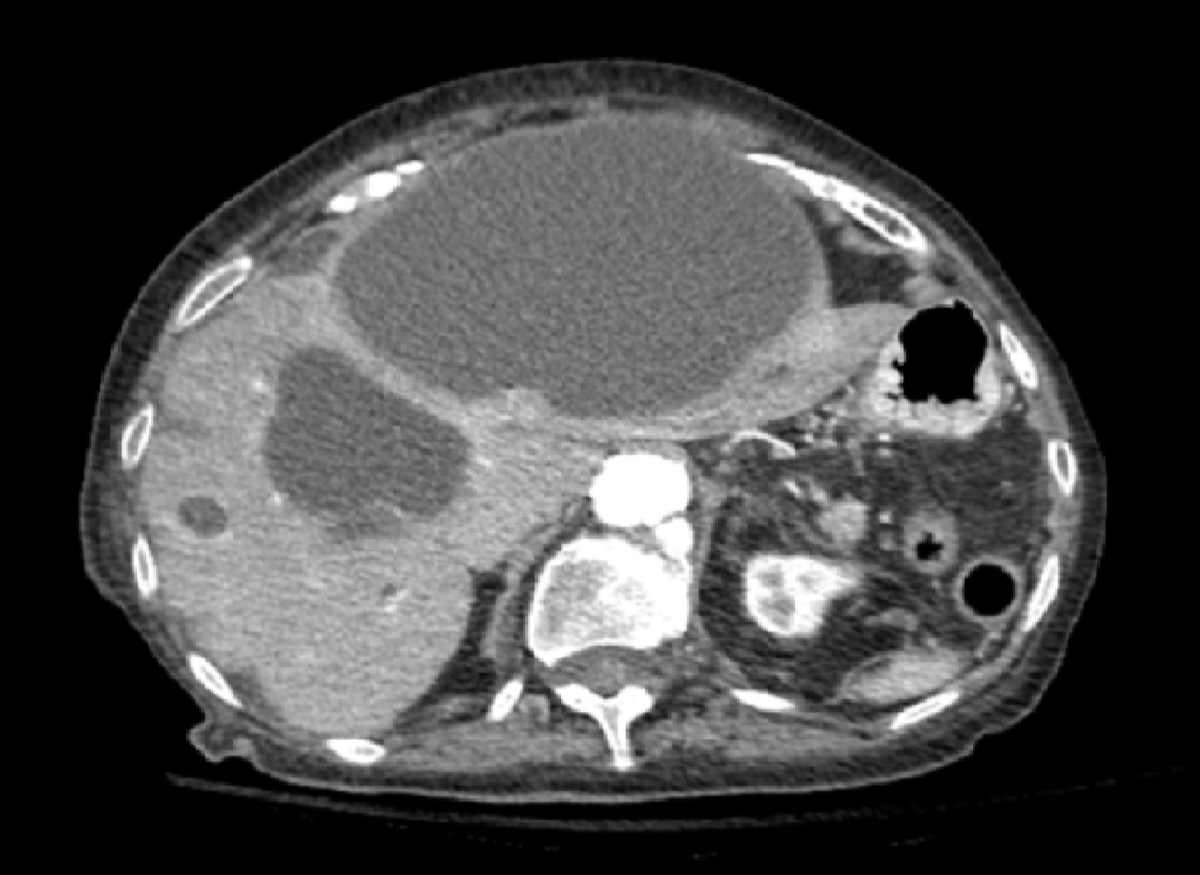Monday Poster Session
Category: Liver
P3828 - Hepatic Cyst Causing Celiac Artery Compression: A Case Report
Monday, October 27, 2025
10:30 AM - 4:00 PM PDT
Location: Exhibit Hall
- EO
Elaine Ognjanovski, DO (she/her/hers)
Henry Ford Health
Warren, MI
Presenting Author(s)
Elaine Ognjanovski, DO1, Ermal Hasalliu, DO2, Kaiser Kabir, DO1, Cassie Konja, DO1
1Henry Ford Health, Warren, MI; 2Henry Ford Health, Detroit, MI
Introduction: Hepatic cysts are common benign lesions detected incidentally on imaging. Although typically asymptomatic, large cysts can compress adjacent structures. A rare but notable complication is compression of the celiac artery, which can mimic celiac artery compression syndrome caused by the median arcuate ligament, leading to postprandial abdominal pain, nausea, and weight loss. We describe an unusual case of hepatic cysts exerting mass effect on the celiac artery, highlighting the importance of considering vascular involvement in symptomatic patients.
Case Description/
Methods: An 89-year-old female with a past medical history of cholecystectomy, diverticulosis, chronic obstructive pulmonary disease, and breast cancer presented with a chief complaint of right upper quadrant abdominal pain, postprandial discomfort, weight loss, and increasing abdominal girth for one month, worsening over the past 6 days. CT abdomen and pelvis revealed a new, large rim-enhancing fluid collection in the abdominal wall, biliary ductal dilation, and enlargement of a known left hepatic lobe cyst, causing celiac artery compression. A pigtail drain was placed, and empiric antibiotics were initiated. Fluid cytology was negative and cultures grew Klebsiella pneumoniae. Further workup with MRCP and MRI of the pelvis showed decreasing hepatic cyst size, biliary duct dilation, and no lymphadenopathy. Repeat CT imaging showed near complete drainage of the hepatic cyst and resolution of the abdominal wall fluid collection. The patient’s symptoms and appetite improved, and she was discharged to inpatient rehabilitation. Outpatient workup with ERCP revealed a biliary filling defect and polypoid lesion. A retrieval balloon was used to sweep the common bile duct, and biliary sphincterotomy was performed. Cholangiogram confirmed resolution of the filling defects.
Discussion: Hepatic cysts are fluid-filled lesions that tend to have a benign course, not commonly requiring intervention. However, large lesions may cause rare vascular complications such as celiac artery compression, contributing to symptoms like postprandial pain and weight loss. In this case, biliary duct compression was also present and addressed outpatient. Diagnosis may be delayed due to the vague nature of abdominal symptoms, and consideration of vascular involvement is essential. This case emphasizes the importance of early recognition of mass effect from hepatic cysts, preventing potentially serious complications.

Figure: Figure 1: CT abdomen/pelvis with contrast showing new rim-enhancing fluid collection in the mid anterior superior abdominal wall measuring 62 x 18 mm, superficial to the left hepatic lobe cyst
Disclosures:
Elaine Ognjanovski indicated no relevant financial relationships.
Ermal Hasalliu indicated no relevant financial relationships.
Kaiser Kabir indicated no relevant financial relationships.
Cassie Konja indicated no relevant financial relationships.
Elaine Ognjanovski, DO1, Ermal Hasalliu, DO2, Kaiser Kabir, DO1, Cassie Konja, DO1. P3828 - Hepatic Cyst Causing Celiac Artery Compression: A Case Report, ACG 2025 Annual Scientific Meeting Abstracts. Phoenix, AZ: American College of Gastroenterology.
1Henry Ford Health, Warren, MI; 2Henry Ford Health, Detroit, MI
Introduction: Hepatic cysts are common benign lesions detected incidentally on imaging. Although typically asymptomatic, large cysts can compress adjacent structures. A rare but notable complication is compression of the celiac artery, which can mimic celiac artery compression syndrome caused by the median arcuate ligament, leading to postprandial abdominal pain, nausea, and weight loss. We describe an unusual case of hepatic cysts exerting mass effect on the celiac artery, highlighting the importance of considering vascular involvement in symptomatic patients.
Case Description/
Methods: An 89-year-old female with a past medical history of cholecystectomy, diverticulosis, chronic obstructive pulmonary disease, and breast cancer presented with a chief complaint of right upper quadrant abdominal pain, postprandial discomfort, weight loss, and increasing abdominal girth for one month, worsening over the past 6 days. CT abdomen and pelvis revealed a new, large rim-enhancing fluid collection in the abdominal wall, biliary ductal dilation, and enlargement of a known left hepatic lobe cyst, causing celiac artery compression. A pigtail drain was placed, and empiric antibiotics were initiated. Fluid cytology was negative and cultures grew Klebsiella pneumoniae. Further workup with MRCP and MRI of the pelvis showed decreasing hepatic cyst size, biliary duct dilation, and no lymphadenopathy. Repeat CT imaging showed near complete drainage of the hepatic cyst and resolution of the abdominal wall fluid collection. The patient’s symptoms and appetite improved, and she was discharged to inpatient rehabilitation. Outpatient workup with ERCP revealed a biliary filling defect and polypoid lesion. A retrieval balloon was used to sweep the common bile duct, and biliary sphincterotomy was performed. Cholangiogram confirmed resolution of the filling defects.
Discussion: Hepatic cysts are fluid-filled lesions that tend to have a benign course, not commonly requiring intervention. However, large lesions may cause rare vascular complications such as celiac artery compression, contributing to symptoms like postprandial pain and weight loss. In this case, biliary duct compression was also present and addressed outpatient. Diagnosis may be delayed due to the vague nature of abdominal symptoms, and consideration of vascular involvement is essential. This case emphasizes the importance of early recognition of mass effect from hepatic cysts, preventing potentially serious complications.

Figure: Figure 1: CT abdomen/pelvis with contrast showing new rim-enhancing fluid collection in the mid anterior superior abdominal wall measuring 62 x 18 mm, superficial to the left hepatic lobe cyst
Disclosures:
Elaine Ognjanovski indicated no relevant financial relationships.
Ermal Hasalliu indicated no relevant financial relationships.
Kaiser Kabir indicated no relevant financial relationships.
Cassie Konja indicated no relevant financial relationships.
Elaine Ognjanovski, DO1, Ermal Hasalliu, DO2, Kaiser Kabir, DO1, Cassie Konja, DO1. P3828 - Hepatic Cyst Causing Celiac Artery Compression: A Case Report, ACG 2025 Annual Scientific Meeting Abstracts. Phoenix, AZ: American College of Gastroenterology.

